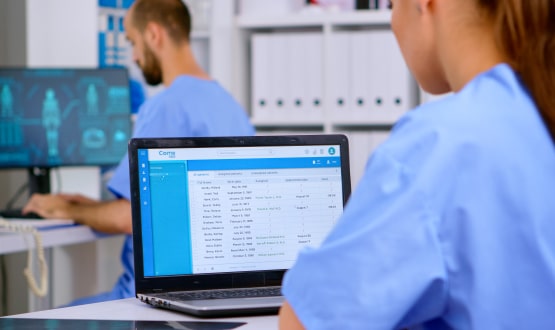Pretty darn Tooting
- 7 August 2015

In the paediatric intensive care unit of St George’s Hospital in Tooting, computer terminals snake down from the ceiling above every patient cubicle.
A nurse sits at the end of a patient bed tapping in her notes. She interrupts her task to tell Digital Health News that this new way of working saves her time: “I’m used to using technology rather than writing notes,” she says.
The trust’s chief clinical information officer, Dr Martin Gray, explains that the PICU was the first part of the hospital to go live with clinical documentation as part of St George’s implementation of the Cerner Millennium electronic patient record in February 2014 and an electronic prescribing and medicines administration system in June last year.
While no coincidence that the first area to go-live is also home to the trust’s CCIO, Gray, a paediatric intensivist, says the unit was also used as a testbed because the roll-out team reasoned that if something can be done in the PICU, it can be done anywhere.
“It’s the most complex area because of the bandwidth of information and the complexities of paediatric practice and disease spectrum and paediatric prescribing,” he explains.
“It would be a lie to say it wasn’t challenging. It was very difficult and we did use a lot of support, but within about six weeks it started to settle down and it’s become normal practice.”
Early assessments of the change indicate is has improved quality and patient safety as well as saving time for staff. Having patient information available in real-time means Gray can supervise junior staff from home and a range of specialists can contribute to PICU patients’ care from a distance.
A sister on the ward, Senal Soyer, prefers the electronic system over paper. “It does save time, especially if you are falling behind, as you can go back and record what happened half an hour ago. You can follow the deterioration or improvement of a patient and analyse what’s happened.”
A mission to make medication safe
Following successful pilots in the PICU, more than 40% of inpatient areas are now live with clinical documentation and ePMA.
In the cardiac unit, senior sister Breege Steffington admits she was a little resistant to digitisation initially, but with good input and trouble shooting, things soon got better. Now she would never want a return to paper.
While at first it took longer to prescribe drugs electronically, over time the process has become easier and shorter. The system also prevents drug errors and is part of day-to-day working, she adds.
This kind of feedback is music to the ears of lead pharmacist for IT Will Hall, who is on a mission to make sure that medication is safe for every patient every time and believes the ePMA is key to achieving that.
The system is “closed loop”, in that a staff member has to scan both the patient’s wristband and the medication before it can be administered, and includes some decision support around allergies and known drug interactions.
Any mismatch between the band and the drug means that a staff member cannot proceed with its administration, preventing potentially harmful medication errors.
To underline the scale of potential error without the system, nearly 900 incorrect wristbands and more than 5,000 incorrect medications have been scanned and recorded since it went live last June.
Hall says some of the most challenging areas of the trust were covered in last year’s deployment, so he is hoping for a relatively smooth roll-out next year.
St George’s is using money from the ‘Safer Hospitals, Safer Wards: Technology Fund’ to roll-out ePMA in anaesthesia, which is next to go-live, followed by oncology.
Many strands make ‘lite’ work
Back in the IT department, chief information officer John-Jo Campbell details how the trust agreed a five-year plan in 2013 to move to a paper-lite environment.
The first of seven strands in the strategy is the development of the EPR for the acute divisions, which are driven by Millennium.
St George’s received Millennium from BT as part of the National Programme for IT in early 2010 and has chosen to retain the system beyond the end of its national contract this October.
Now that it has its own contract with Cerner, the trust will take the latest 2015 code base, which has a more anglicised approach to patient administration.
It will also extend its use of clinical documentation and e-prescribing to remaining inpatient areas from April next year. There are still 147 other clinical systems in use at the trust and, while Campbell does not believe “one size fits all,” this number will reduce over time.
Clinical change lead Jenny Muir says that 20 ‘champion users’ were put in place for last year’s deployment and their impact has been “exceptionally well evaluated.”
Champions are staff from across the organisation seconded to the EPR programme full-time in order to be trained as super users, who support their colleagues during and after go-lives.
The difference that makes champion users more successful than floor walkers is that they understand not only the IT, but also the trust as an organisation and they have a clinical background, Muir says.
Backing it up, tying it together
The second strand in the strategy is digitising the paper records via an electronic document management programme, which is running in parallel to the EPR programme.
The third is around taking information being collected by the trust’s systems and relaying that back more effectively, both to the organisation in order to manage patient flows and process, and to healthcare professionals to inform working practice.
The fourth strand is infrastructure and involves a lot of work to bring the wi-fi network up to scratch to support more mobile working and integration between devices and the EPR.
A further workstream is focussed on making sure that information is accessible in a timely fashion to GPs and other health care providers, and also to patients and their carers. This is being achieved via the introduction of a portal from Orion.
And the final strand is about ensuring the trust has the right governance in place to determine the priorities of the paper-lite programme and to make sure that what it is doing is clinically appropriate and safe.
This means greater transparency about how decisions are made and ensuring these are driven by organisational requirements.
Campbell admits that while that strand of work has helped to increase engagement, the programme still struggles with getting the involvement of the right people at the right time.
“Engagement is key, that’s more important than the tools we are using which are relatively established and technically robust,” he says.
“They will have to be well implemented and deployed, but the challenges are more about getting engagement, making sure it’s on the trust priorities in an appropriate fashion, and that collectively, as an organisation and health economy, we are fully exploiting some of the new opportunities that a change in working practice gives us.”




